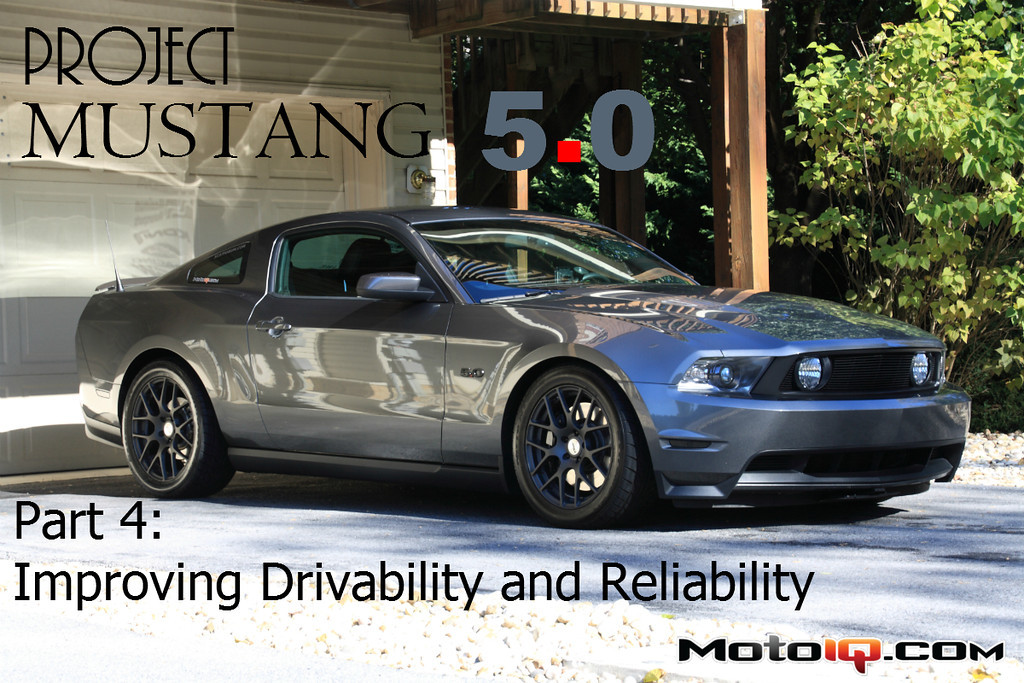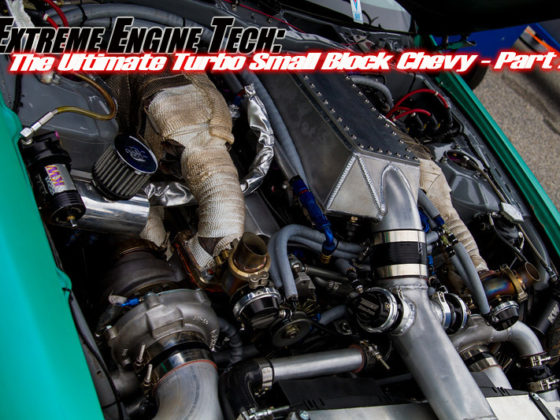,
 Strength: Typical rod-ends won’t stand up to the abuse that the upper control arm takes (go watch those videos again), so BMR utilized the largest spherical bearing I’ve ever seen.
Strength: Typical rod-ends won’t stand up to the abuse that the upper control arm takes (go watch those videos again), so BMR utilized the largest spherical bearing I’ve ever seen.The upper control arm is one of the most-stressed parts of the S197 Mustang, so BMR took no chances. They apparently decided that this control arm needed to withstand a tactical nuclear detonation. Whereas a typical 0.75” rod end is rated at “only” 29,000 pounds, BMR utilized a 1” Teflon-lined bearing instead, because it was rated at 90,000 pounds. They CNC machined that cup up there that holds the bearings, along with the rest of the piece, from aircraft-grade aluminum. They then painted it bright red, because racecar.
BMR’s Ultimate upper control arm requires a new mount, which they also sent me. The new mount features two different holes, allowing adjustment of instant center and anti-squat geometry. Like every other BMR part, it is also beautifully crafted and extremely strong.
 The mount in this picture is actually upside down; it mounts to the underside of the chassis. The hole closest to the chassis is for stock geometry and the farther hole (which is lower when installed) increases anti-squat and lowers the instant center. Because I’ve already increased anti-squat using the lower control arm mounts, I opted to keep the stock geometry.
The mount in this picture is actually upside down; it mounts to the underside of the chassis. The hole closest to the chassis is for stock geometry and the farther hole (which is lower when installed) increases anti-squat and lowers the instant center. Because I’ve already increased anti-squat using the lower control arm mounts, I opted to keep the stock geometry.JPC installs upper control arms in their sleep, so it only took about an hour for them to bolt this thing on. Installation of an upper control arm requires a drive-on lift, because in order to set pinion angle properly the suspension must be loaded. Recall that on a live-axle car, the rear of the driveshaft must move up and down with the axle. The angle that the driveshaft pinion makes with the actual driveshaft is called the pinion angle, and it is measured when the car is at rest. The driveshaft is designed to operate best when it has a near-stock angle, and lowering the car has the effect of pushing the axle up closer to the chassis and thus changing the pinion angle. The easiest method of adjusting this is to change the length of the upper control arm, which has the effect of rotating the entire axle about the lower control arm mounts and thus altering the pinion angle. Project Mustang 5.0 had had a slight vibration at 70 mph ever since it was lowered several years ago due to an incorrect pinion angle. This vibration has now disappeared.
 Here’s the upper control arm installed and adjusted. It is an absolutely gorgeous piece, and it’s a shame that you pretty much can’t see it once it’s on the car. (Source: BMR Suspension, because the piece is so hard to see I couldn't even get a good shot of it on my own car.)
Here’s the upper control arm installed and adjusted. It is an absolutely gorgeous piece, and it’s a shame that you pretty much can’t see it once it’s on the car. (Source: BMR Suspension, because the piece is so hard to see I couldn't even get a good shot of it on my own car.)The last order of business was to grease the poly bushings and protect the spherical bearings. Non-synthetic dino grease will eat away polyurethane, so synthetic grease must be used instead. BMR recommends Green synthetic marine grease, which can be picked up at most auto parts stores. Spherical bearings wear out faster if they get dirty, so BMR also recommends spraying them periodically with motorcycle chain lubricant, which is a special type of oil that hardens into a wax-like substance once applied, helping to keep dirt out. I stopped by my local powersports shop and picked up a can of PJ1 Blue Label chain lube on their recommendation.
Now it was time to test out the suspension!
I’m going to be honest: I expected all those Heim joints and spherical bearings to be extremely noisy, but I was completely wrong. I noticed almost no difference over using all polyurethane bushings, a testament to the efficacy of BMR’s having such tight manufacturing tolerances. The only thing I did notice was that if the windows were up, the radio off, and the car coasting to a stop, you could hear a slight gear whine from the solid parts transmitting NVH into the cabin. But when I say “slight,” I mean you have to actively be listening for it. (And most Mustang’s exhausts are loud enough to cover that up.)
The real test was at an autocross. The difference was immediately apparent upon the first stab of the throttle at the start line: the lack of compliance in the rod ends translated into what felt like far better throttle and brake response. Before, the bushings would take a moment to compress before the torque from the motor pushed the car forward, and that slop was now gone. However, what was even more impressive was the cornering response!
Before, especially on fast transitions like slaloms, the rear end would have to “settle” after every turn before you could reliably get it to steer in another direction. This “settling” was caused by the bushings compressing and decompressing—like an oscillating spring. This is especially the case on the panhard rod, which laterally locates the rear axle and thus compresses its bushings each time the car goes around a corner hard. Eliminating bushings eliminated almost all of that sloppiness, resulting in a car that was much easier to drive through quick transitions.

I feel that a large part of the cornering response improvement is due to the panhard rod. During a hard corner, the panhard rod must keep the axle centered under the rear of the car. If the car is turning, the axle wants to keep moving straight (due to Newton’s First Law), and the panhard rod is the main mechanism by which the axle is brought in line. In order to do this, the panhard rod “pushes” or “pulls” on the axle, which compresses the bushings on both sides of the rod. The small amount of time needed to compress both bushings before the force of the steering can be transmitted to the axle is what creates slop and what causes the rear end to feel “unsettled” for a brief amount of time during transitions.
I must say I am very surprised by the difference that the BMR rear suspension made to Project Mustang 5.0. Not only does it corner extremely tightly and without drama (due to the lack of bushing compliance and “settling”), but it launches extremely hard due to the complete lack of wheel hop caused by stiffer bushings and rod ends. Project Mustang might just end up being drag raced a bit now, because those hard launches get addictive.
Source



